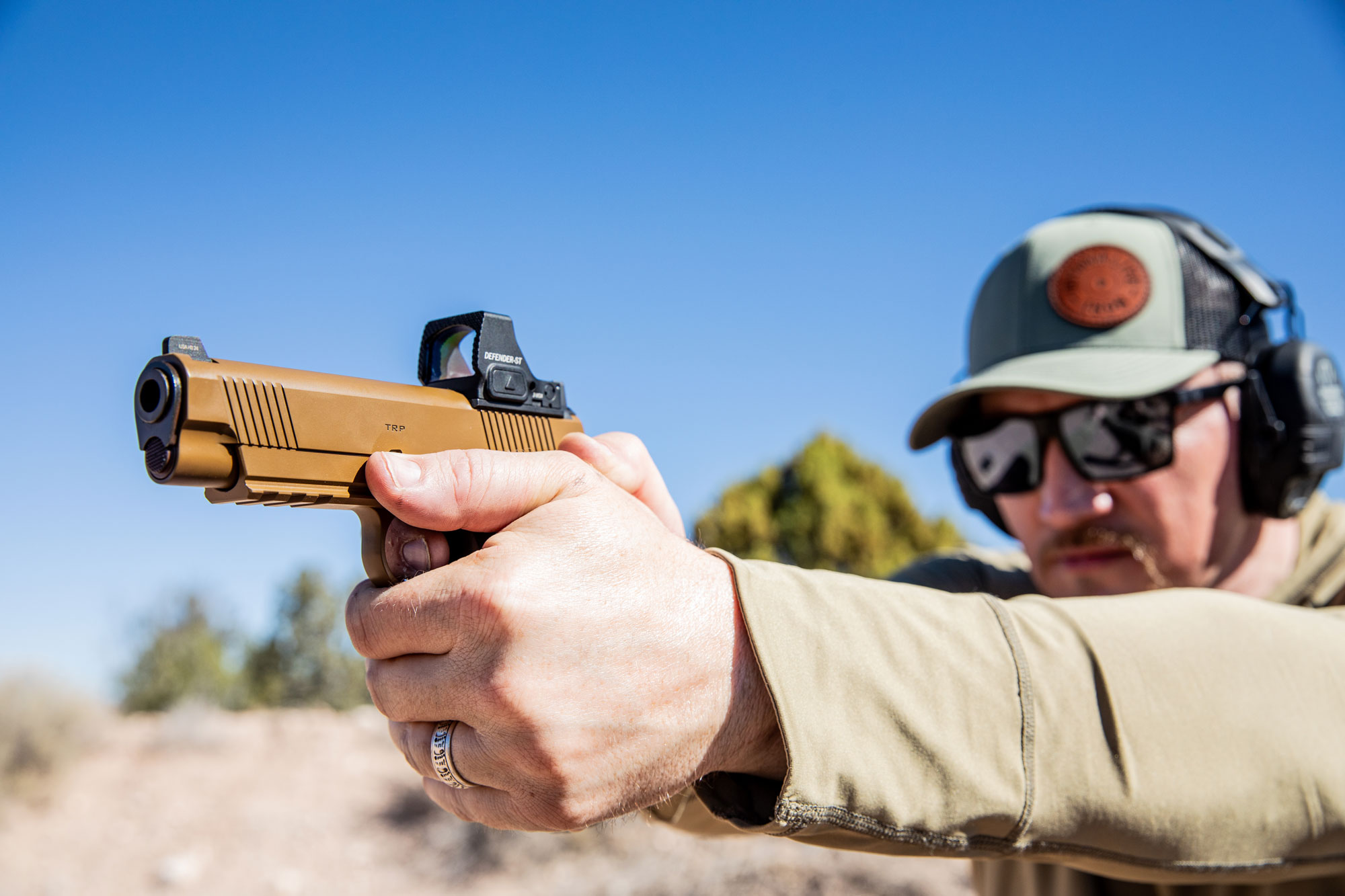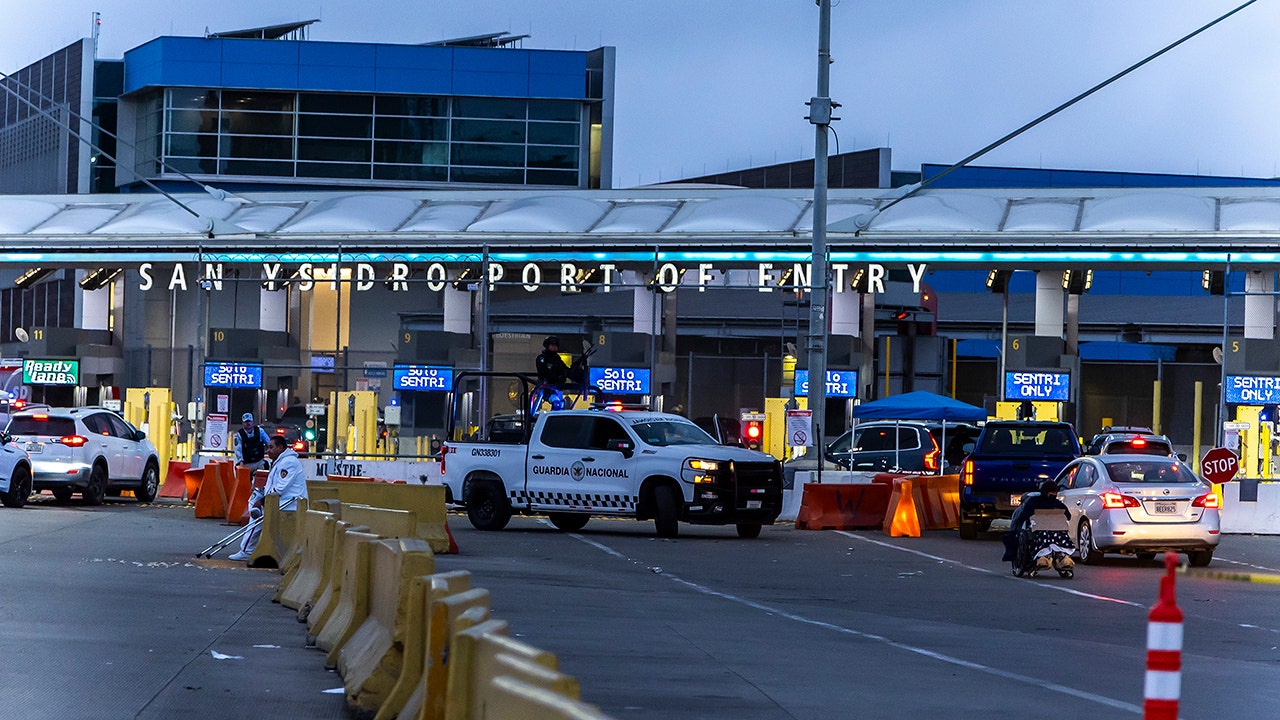We may earn revenue from the products available on this page and participate in affiliate programs. Learn More ›
Springfield Armory’s concealed-carry 1911 TRP is a new and versatile addition to their stable of top-tier 1911 pistols. This particular model will appeal to single-stack fans that want a reliable easy shooter that’s suitable for everyday carry. It’s a Commander-sized gun that sports a bobbed frame and sweeping beavertail, while also incorporating a modern low-profile optic cut and light rail. Chambered in 9mm, it captures everything we like about the classic single-stack 1911 design and is a great choice for a modern concealed-carry pistol.
Springfield 1911 TRP 4.25-inch CC 9mm AOS Specs
Sean Murphy
See It
Pros
- Great accuracy
- Ambidextrous safey levers
- Bobbed frame reduces printing
- Good trigger
- Optic ready
Cons
- Grip is too harsh for some shooters
- Erratic ejection
- Limited 9+1 capacity
- Caliber: 9mm
- Capacity: 9+1
- Action: Single-action, hammer-fired
- Barrel: 4.25-inch, stainless steel, match grade
- Dimensions: inches 7.8 inches (L) x 5.5 inches (H) x 1.5 inches (W across safety switches)
- Weight: 31 ounces (with empty 9-round magazine and no optic) (measured)
- Frame: Forged aluminum, carry contour
- Slide: Carbon steel, forged
- Optics: Cut for optic, uses Agency Optics System (AOS) plates
- Controls: Right-handed slide stop, mag catch, ambidextrous safety levers
- Finish: Coyote Brown Cerakote
- Grip: VZ Hydra G-10 stocks
- Sights: Tritium front sight, serrated U-notch rear
- Trigger: Skeletonized, single-action, curved shoe, 4 pounds, 4 ounces (measured)
- Price: $1,879
Key Features
- Single-stack magazine
- Concealed-carry frame contour
- Aggressive grip texture
- Agency Optics adapter plates
- Ambidextrous thumb safety
A Modern Commander 1911
Most shooters correctly associate the 1911 with the .45 ACP cartridge with which it was launched, but incorrectly think of the Commander version as simply a shortened version of that forty-five. In the late 1940s, the 1911 Commander was an answer to the military’s desire for a lighter service pistol than the classic 1911 A1 — which had already been in service for nearly 40 years. It was requested to be chambered in 9mm, with weight and size requirements that resulted in a 4.25-inch barrel and aluminum alloy frame. Many versions of the Colt Commander have been produced, and initially the pistols were chambered in .38 Super and .45 ACP in addition to 9mm.

Springfield TRP 4.25-inch CC AOS: True to Commander Form
In its basic configuration, Springfield’s new TRP pistol conforms to what was desired in a lighter alternative to the full-sized 1911 pistol. It’s got a 4.25-inch 9mm barrel, 9-round single-stack magazine, and aluminum frame, which are all 75-year-old qualifications. It employs a standard slide stop lever and takedown pin, single recoil spring, and short GI-length guide rod. At the muzzle, the barrel is supported by a GI-style barrel bushing which retains the spring plug.
What makes this pistol relevant in the modern era is its compatibility with optics and lights, which caters to contemporary carry and shooting practices and styles.
Agency Optics Cut
One of the most significant updates that Springfield has folded into the TRP platform is the deep optic cut that works with Agency Optics System adapter plates. This allows optics to be mounted low and close to the bore axis and with most red dots, you’re able to co-witness the medium-height iron sights — a benefit in the event your optic goes down.
A more significant strong point of this low-sitting optic system is that with the sight close to the bore axis, it’s easier to keep your dot in the window as the gun cycles. That gives the shooter a huge advantage for speed and accuracy.
The AOS system accommodates a variety of enclosed and open-emitter red dots such as Leupold’s DPP, Trijicon RMR, and the Vortex Defender ST, which is what I ran on the pistol. The TRP AOS comes with a cover plate installed, which has a black serrated rear sight and is secured by two screws. The rear of the optic cut features a slanted notch which, in addition to helping hold the rear of the plate down, adds longitudinal support to reduce shear force on the screws. Despite this, it’s still a large plate to be secured by two screws and I had some issues with the plate screws loosening during high-volume shooting.
Grip and Frame
Aside from the AOS optic cut, the grip and frame are the most notable modernized components. One striking feature is the bobbed, or cut down, grip. Where the rear of a traditional 1911 grip has a sharp corner at the bottom, this one angles forward to the rear of the magwell — looking as if someone just lopped the corner off a traditional 1911 frame. This small but meaningful change helps prevent the rear of the grip from printing — making an imprint through a shirt or jacket — while concealed. It’s especially beneficial for those who carry on their hip or inside the waistband in front of the hips.
The dust cover at the front of the frame incorporates a three-slot Picatinny rail for mounting a light. It’s an attribute that modern shooters expect and, unlike many single-slot rails, it supports a wide variety of lights.

An Aggressive Grip
One of the first things you’ll notice about the 1911 TRP 4.25-inch CC when you pick it up is its aggressive grip texture. There are few things more frustrating than having your pistol slip around in your sweaty hands like a pan-sized rainbow trout. That’s a non-issue with this pistol. It combines the aggressive VZ Hydra G10 grips with sharp pyramidal checkering on the front strap and below the grip safety on the rear.
Some shooters will find this one-two combo of grip textures to be too abrasive. When I started shooting it, the handle felt like a cheese grater and the integrity of my hand was only preserved by the need to reload so often. After several hundred rounds, however, I don’t mind it as much. To be fair, this isn’t intended to be a high-volume blaster and, considering it’s a defensive gun, the aggressiveness of the grip has grown on me. If there’s a certainty, it’s that this pistol won’t be sliding anywhere.
For concealed carry, the grip texture might cause some discomfort — depending on carry style. It doesn’t seem to snag on clothing or prevent an outer layer from hanging naturally, but it could cause some discomfort if carried directly against the skin.
Read Next: Best 1911 Handguns, Tested and Reviewed
Shooting the Springfield 1911 TRP CC AOS
The sharpness of the grip texturing and very stiff safety levers gave me a sour first impression of this new Springfield TRP, but I’m glad I kept with it. I brought the pistol to our annual gun test, just prior to its public release, to be tested by our whole panel of experienced shooters. Whether it was home field advantage in the dusty steel pits and packed gravel flat ranges at Gunsite Academy — the 1911 shooter’s Mecca — or simply well-earned respect, everyone on the team liked the TRP.
Accuracy
We tested the accuracy potential of the Springfield TRP 4.25-inch CC AOS by recording five five-shot groups from 15 yards from a supported position using a shooting bag atop a tripod. We did this with two different types of ammo, Staccato Match 136-grain OTM and Hornady American Gunner +P 124-grain XTP. Here’s a look at the average group sizes:
Staccato Match 136-grain OTM: 1.03 inches
Hornady American Gunner +P 124-grain XTP: 1.45 inches
We have adopted the Staccato match ammo as an accuracy testing load because it shoots quite well in a variety of guns, and the Springfield TRP produced stellar results. For comparison, most good-shooting pistols with a red dot we have tested average around 1.5 inches for five-shot groups at 15 yards. This one was one of the most accurate concealed-carry handguns we have seen — only bested by the Staccato CS.
The level of precision is a little surprising considering the more basic style barrel bushing and short guide rod, but the match-grade barrel does lock up quite securely with the slide. In fact, the fit is such that it takes some manipulation to get the barrel clear of the locking recesses in order to remove it from the slide during disassembly.
Whatever the cause, it’s a damn accurate pistol, and we could easily hit Gunsite vital zone steel plates from 50 yards in unsupported shooting with the TRP.

A Test Team Favorite
With every magazine we put through the Springfield TRP, the entire test team liked it more. It points with a classic 1911 intuitiveness and has a smooth recoil cycle. With some time, the stiff safety levers smoothed out, but not to the point of becoming sloppy in any way.
The pistol has a fully-supported feed ramp and, despite the 1911 being king of feed-ramp stoppages, we never experienced any malfunctions with the gun. One thing we did note is that it pukes brass from the ejection port in random directions and without much force — some of which would fall directly back down onto the gun or the shooter’s arms. This could indicate a weak extractor.
Most shooters on the test team noted how easy it was to shoot this pistol accurately and that its only significant shortcoming was the 10-round capacity. “It just runs out of bullets too fast,” one tester stated. Though this model hasn’t been cleared as California compliant, several other TRP models have, and this would be a great choice for shooters in that state if or when it’s allowed.
Ergonomic and Handling Downsides
A slimmer single-stack grip has some advantages for concealed carry, but it’s notably more sensitive to left or right trigger pressure than many double-stack pistols. This manifests itself in left or right impacts, and can be seen while dry firing. If your red dot jumps to the left or right when pulling the trigger, your finger isn’t correctly placed. It’s not pulling directly rearward. Mastering this is a marksmanship fundamental. But this single-stack pistol is observably more sensitive to horizontal trigger input than a premium double-stack 1911 like the Staccato CS or Springfield’s double-stack Prodigy.
You’ll either like the sharp grip texture, or you won’t. However, one small detail that would really improve handling of the TRP is to bevel the sharp checkering and edges at the front of the magwell. The sides and the rear have a slight bevel, but smoothing out the sharp edges at the front would really help with quick reloads. As is, the checkering in that location doesn’t really add performance value to the grip.

Final Thoughts
If you’re looking for a single-stack 1911 that’s not only accurate and fun to shoot, but a great practical concealed-carry pistol, the Springfield 1911 TRP CC AOS is certainly worth considering. It’s a solid value for what it brings to the table compared to both cheaper and more expensive options.
Ultimately, this is a great modern iteration of the Commander-style 1911 that transcends the simple needs of a practical defensive handgun. It’s a hundred and ten years of nostalgia folded into a fully modern pistol. If you start shooting one, it will probably grow on you too.
Read the full article here












